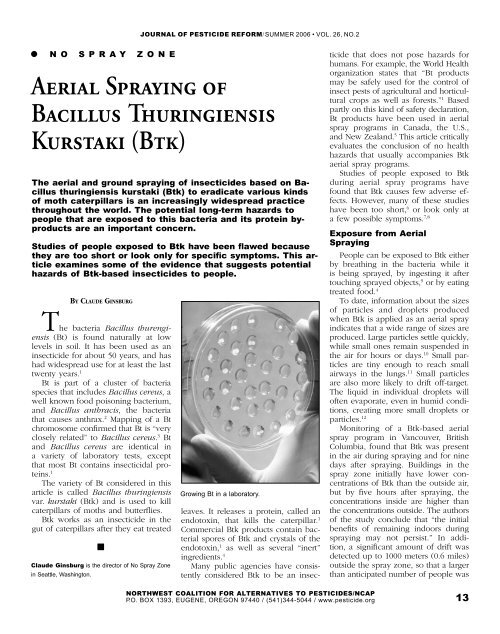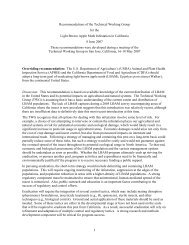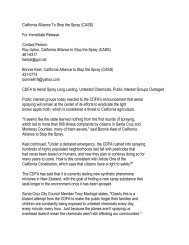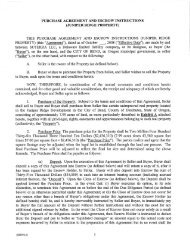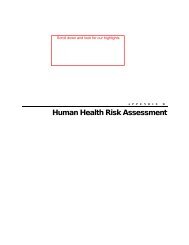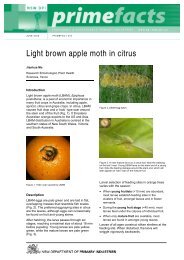Aerial Spraying of Bacillus Thuringiensis Kurstaki ... - LBAMspray.com
Aerial Spraying of Bacillus Thuringiensis Kurstaki ... - LBAMspray.com
Aerial Spraying of Bacillus Thuringiensis Kurstaki ... - LBAMspray.com
Create successful ePaper yourself
Turn your PDF publications into a flip-book with our unique Google optimized e-Paper software.
JOURNAL OF PESTICIDE REFORM/ SUMMER 2006 • VOL. 26, NO.2<br />
N o S P R A Y Z O N E<br />
<strong>Aerial</strong> <strong>Spraying</strong> <strong>of</strong><br />
<strong>Bacillus</strong> <strong>Thuringiensis</strong><br />
<strong>Kurstaki</strong> (Btk)<br />
The aerial and ground spraying <strong>of</strong> insecticides based on <strong>Bacillus</strong><br />
thuringiensis kurstaki (Btk) to eradicate various kinds<br />
<strong>of</strong> moth caterpillars is an increasingly widespread practice<br />
throughout the world. The potential long-term hazards to<br />
people that are exposed to this bacteria and its protein byproducts<br />
are an important concern.<br />
Studies <strong>of</strong> people exposed to Btk have been flawed because<br />
they are too short or look only for specific symptoms. This article<br />
examines some <strong>of</strong> the evidence that suggests potential<br />
hazards <strong>of</strong> Btk-based insecticides to people.<br />
By Claude Ginsburg<br />
The bacteria <strong>Bacillus</strong> thurengiensis<br />
(Bt) is found naturally at low<br />
levels in soil. It has been used as an<br />
insecticide for about 50 years, and has<br />
had widespread use for at least the last<br />
twenty years. 1<br />
Bt is part <strong>of</strong> a cluster <strong>of</strong> bacteria<br />
species that includes <strong>Bacillus</strong> cereus, a<br />
well known food poisoning bacterium,<br />
and <strong>Bacillus</strong> anthracis, the bacteria<br />
that causes anthrax. 2 Mapping <strong>of</strong> a Bt<br />
chromosome confirmed that Bt is “very<br />
closely related” to <strong>Bacillus</strong> cereus. 3 Bt<br />
and <strong>Bacillus</strong> cereus are identical in<br />
a variety <strong>of</strong> laboratory tests, except<br />
that most Bt contains insecticidal proteins.<br />
1<br />
The variety <strong>of</strong> Bt considered in this<br />
article is called <strong>Bacillus</strong> thuringiensis<br />
var. kurstaki (Btk) and is used to kill<br />
caterpillars <strong>of</strong> moths and butterflies.<br />
Btk works as an insecticide in the<br />
gut <strong>of</strong> caterpillars after they eat treated<br />
Claude Ginsburg is the director <strong>of</strong> No Spray Zone<br />
in Seattle, Washington.<br />
Growing Bt in a laboratory.<br />
leaves. It releases a protein, called an<br />
endotoxin, that kills the caterpillar. 1<br />
Commercial Btk products contain bacterial<br />
spores <strong>of</strong> Btk and crystals <strong>of</strong> the<br />
endotoxin, 1 as well as several “inert”<br />
ingredients. 4<br />
Many public agencies have consistently<br />
considered Btk to be an insec-<br />
ticide that does not pose hazards for<br />
humans. For example, the World Health<br />
organization states that “Bt products<br />
may be safely used for the control <strong>of</strong><br />
insect pests <strong>of</strong> agricultural and horticultural<br />
crops as well as forests.” 1 Based<br />
partly on this kind <strong>of</strong> safety declaration,<br />
Bt products have been used in aerial<br />
spray programs in Canada, the U.S.,<br />
and New Zealand. 5 This article critically<br />
evaluates the conclusion <strong>of</strong> no health<br />
hazards that usually ac<strong>com</strong>panies Btk<br />
aerial spray programs.<br />
Studies <strong>of</strong> people exposed to Btk<br />
during aerial spray programs have<br />
found that Btk causes few adverse effects.<br />
However, many <strong>of</strong> these studies<br />
have been too short, 6 or look only at<br />
a few possible symptoms. 7,8<br />
Exposure from <strong>Aerial</strong><br />
<strong>Spraying</strong><br />
People can be exposed to Btk either<br />
by breathing in the bacteria while it<br />
is being sprayed, by ingesting it after<br />
touching sprayed objects, 9 or by eating<br />
treated food. 4<br />
To date, information about the sizes<br />
<strong>of</strong> particles and droplets produced<br />
when Btk is applied as an aerial spray<br />
indicates that a wide range <strong>of</strong> sizes are<br />
produced. Large particles settle quickly,<br />
while small ones remain suspended in<br />
the air for hours or days. 10 Small particles<br />
are tiny enough to reach small<br />
airways in the lungs. 11 Small particles<br />
are also more likely to drift <strong>of</strong>f-target.<br />
The liquid in individual droplets will<br />
<strong>of</strong>ten evaporate, even in humid conditions,<br />
creating more small droplets or<br />
particles. 12<br />
Monitoring <strong>of</strong> a Btk-based aerial<br />
spray program in Vancouver, British<br />
Columbia, found that Btk was present<br />
in the air during spraying and for nine<br />
days after spraying. Buildings in the<br />
spray zone initially have lower concentrations<br />
<strong>of</strong> Btk than the outside air,<br />
but by five hours after spraying, the<br />
concentrations inside are higher than<br />
the concentrations outside. The authors<br />
<strong>of</strong> the study conclude that “the initial<br />
benefits <strong>of</strong> remaining indoors during<br />
spraying may not persist.” In addition,<br />
a significant amount <strong>of</strong> drift was<br />
detected up to 1000 meters (0.6 miles)<br />
outside the spray zone, so that a larger<br />
than anticipated number <strong>of</strong> people was<br />
NORTHWEST COALITION FOR ALTERNATIVES TO PESTICIDES/NCAP<br />
P.O. BOX 1393, EUGENE, OREGON 97440 / (541)344-5044 / www.pesticide.org<br />
13
JOURNAL OF PESTICIDE REFORM/ SUMMER 2006 • VOL. 26, NO. 2<br />
Figure 2<br />
Diarrhea Toxins in Bt<br />
Bt found in pasta, bread, and milk<br />
Bt found in soil<br />
Commercial Btk insecticides<br />
(7 strains tested)<br />
strains with<br />
diarrhea toxin<br />
(48 strains tested)<br />
(8 products tested along with one strain <strong>of</strong> <strong>Bacillus</strong><br />
cereus. All contained the diarrhea toxin.)<br />
2500<br />
strains without<br />
diarrhea toxin<br />
Amount <strong>of</strong> diarrhea toxin (titre)<br />
2000<br />
1500<br />
1000<br />
500<br />
0<br />
<strong>Bacillus</strong><br />
cereus<br />
Bt<br />
insecticides<br />
Damgaard, P.H. et al. 1996. Enterotoxin-producing strains <strong>of</strong> <strong>Bacillus</strong> thuringiensis isolated from food. Lett. Appl. Microbiology 23:146-150.<br />
Perani, M., A. Bishop, and A. Vaid. 1998. Prevalence <strong>of</strong> b-exotoxin, diarrhoeal toxin and specific d-endotoxin in natural isolates <strong>of</strong> <strong>Bacillus</strong> thuringiensis.<br />
FEMS Microbiology Letters 160:55-60.<br />
Damgaard, P.H. 1995. Diarrhoeal enterotoxin production by strains <strong>of</strong> <strong>Bacillus</strong> thuringiensis isolated from <strong>com</strong>mercial <strong>Bacillus</strong> thuringiensis-based<br />
pesticides. FEMS Immunol. Med. Microbiology 12: 245-250.<br />
Bt’s close relative <strong>Bacillus</strong> cereus causes food poisoning because it produces a diarrhea-causing toxin. This toxin is also found in Bt in food, soil,<br />
and <strong>com</strong>mercial Bt insecticides. The amounts <strong>of</strong> the toxin in Bt insecticides are less than they are in <strong>Bacillus</strong> cereus.<br />
exposed. 11<br />
Neither No Spray Zone nor NCAP<br />
has located any measurements <strong>of</strong> exposure<br />
to Btk’s insecticidal proteins or to<br />
other <strong>com</strong>ponents <strong>of</strong> Btk products.<br />
Can Btk Survive in People?<br />
There is evidence that Btk survives<br />
in exposed people. In a study <strong>of</strong> an<br />
aerial spray program in Victoria, British<br />
Columbia, Btk was isolated from nasal<br />
swabs from people who lived in and<br />
outside <strong>of</strong> the spray zone. 13 Btk has also<br />
been isolated from the feces <strong>of</strong> workers<br />
who applied Btk in greenhouses. 14<br />
These researchers also found evidence<br />
that some Btk spores germinated in the<br />
intestines <strong>of</strong> the greenhouse workers.<br />
(Btk spores germinate under conditions<br />
similar to those found in human intestines.<br />
14 ) A study <strong>of</strong> farmworkers who<br />
harvested Btk-treated vegetables found<br />
Btk in nasal swabs, and also evidence<br />
that Btk spores had germinated in the<br />
upper respiratory tract. 15 No Btk-related<br />
illnesses were reported in these studies;<br />
however, two studies measured<br />
immune responses in exposed people<br />
that suggested the development <strong>of</strong> Btk<br />
allergies. 15,16<br />
Btk and Intestinal Illness<br />
<strong>Bacillus</strong> cereus, a bacteria closely<br />
related to Bt, causes two types <strong>of</strong> food<br />
poisoning; one characterized by pain<br />
and diarrhea, the other by nausea and<br />
vomiting. 17 Each type <strong>of</strong> poisoning is<br />
caused by a particular toxin produced<br />
by <strong>Bacillus</strong> cereus. 17 The diarrhea toxin<br />
has been found in <strong>com</strong>mercial Btk insecticides.<br />
18,19 (See Figure 1.) It may be<br />
difficult to find a natural Btk strain that<br />
produces insect toxins while not producing<br />
the food poisoning toxins. 20<br />
There is one documented case <strong>of</strong><br />
Bt causing an outbreak <strong>of</strong> intestinal<br />
illness. 21 The actual number may be<br />
significantly larger. <strong>Bacillus</strong> cereus is<br />
identified as the cause <strong>of</strong> between one<br />
and five percent <strong>of</strong> food poisoning incidents<br />
in several European countries<br />
and the U.S. 21 However, Bt and <strong>Bacillus</strong><br />
cereus are rarely distinguished when<br />
these incidents are studied, 18 and much<br />
<strong>of</strong> the <strong>Bacillus</strong> found on food may actually<br />
be Bt rather than <strong>Bacillus</strong> cereus.<br />
When researchers from the Danish<br />
Institute for Food and Veterinary Research<br />
precisely identified 40 <strong>Bacillus</strong><br />
cereus strains found on ready-to-eat<br />
foods, they decided that 31 <strong>of</strong> them<br />
were actually Bt. The amount <strong>of</strong> <strong>Bacillus</strong><br />
in these foods exceeded Danish<br />
guidelines in about 500 samples. 22 The<br />
diarrhea toxin is produced after the<br />
Bt spore germinates, and this appears<br />
to be possible in human intestines, as<br />
described above. 14<br />
Recent research describes a method<br />
for using genetic engineering to produce<br />
Bt that doesn’t make the diarrhea<br />
toxin. 23 This raises new concerns<br />
about potential hazards to human and<br />
environmental health.<br />
Other Bt Infections<br />
Although rare, there are documented<br />
cases <strong>of</strong> significant Bt infections in<br />
humans. 24,25 In both <strong>of</strong> these cases the<br />
infection occurred in a healthy person,<br />
although one had suffered a serious<br />
war injury. 25 <strong>Bacillus</strong> cereus is known<br />
to have caused infections in people<br />
with immune systems <strong>com</strong>promised by<br />
leukemia and steroid medication. 26 Bt<br />
infections have caused death in laboratory<br />
animals with both <strong>com</strong>promised<br />
14<br />
NORTHWEST COALITION FOR ALTERNATIVES TO PESTICIDES/NCAP<br />
P.O. BOX 1393, EUGENE, OREGON 97440 / (541)344-5044 / www.pesticide.org
JOURNAL OF PESTICIDE REFORM/ SUMMER 2006 • VOL. 26, NO.2<br />
and normal immune systems. 25,27 In<br />
addition, Bt has killed mice infected<br />
with influenza. 28<br />
Bioaerosols<br />
Bioaerosols, found in virtually all<br />
indoor and outdoor environments, are<br />
a <strong>com</strong>plex mixture <strong>of</strong> viruses, fungi,<br />
bacteria, pollens, animal dander, and<br />
spores. 29 The endotoxins, made by bacteria<br />
including Bt, 4 may play a key role<br />
in sensitization and disease caused by<br />
bioaerosols. 5,29 Endotoxins from other<br />
bacteria have been liked to asthma 30<br />
and other airway diseases. 29 Common<br />
symptoms reported after aerial spraying<br />
<strong>of</strong> Bt pesticides include the same symptoms<br />
caused by bioaerosols. 5 Therefore,<br />
it is plausible that Bt bioaerosols might<br />
trigger chronic airway diseases.<br />
Are Btk Infections Associated<br />
with Later Disease?<br />
There is a large body <strong>of</strong> evidence<br />
suggesting that bacterial infections<br />
play a role in the later development<br />
<strong>of</strong> autoimmune diseases. For example,<br />
bacterial infections have been identified<br />
as possible triggers for the development<br />
<strong>of</strong> lupus, 31,32 multiple sclerosis, 33<br />
psoriasis, 34 scleroderma, 35 other skin<br />
diseases, 36 arthritis, 37 and amyotrophic<br />
lateral sclerosis. 38 There has been no<br />
link established between Btk and these<br />
autoimmune diseases, but this possiblility<br />
has not been explored.<br />
Btk Is Still an Unknown<br />
Not enough is known about the<br />
many substances produced by Btk to<br />
accurately predict their effects. For<br />
example, a recent study described a<br />
new protein produced by some Bt<br />
strains. This protein kills some human<br />
cancer cells while being less toxic to<br />
normal cells. 39 Another study identified<br />
proteins in Bt insecticides that cause<br />
disintegration <strong>of</strong> human cells in laboratory<br />
tests. 19<br />
To <strong>com</strong>plicate matters more, there<br />
is evidence that <strong>Bacillus</strong> cereus and Bt<br />
can exchange genetic material. This<br />
means that the genetic material that<br />
produces a disease-causing protein<br />
could be transferred from one bacteria<br />
to another one. This transfer <strong>of</strong><br />
genetic material occurs in the gut <strong>of</strong><br />
earthworms. 2<br />
The ecology <strong>of</strong> Bt in the soil is also<br />
poorly understood. 2<br />
Conclusions<br />
Considerable questions remain about<br />
the health effects <strong>of</strong> Btk. In keeping<br />
with the precautionary principle, No<br />
Spray Zone believes that there is not<br />
sufficient evidence <strong>of</strong> safety to humans<br />
and the environment to continue to<br />
expose large populations to aerial<br />
applications <strong>of</strong> Btk.<br />
Possible risks to public health are<br />
exacerbated in large-scale insect eradication<br />
and control programs because<br />
these programs are designed and administered<br />
primarily by entomologists.<br />
Entomologists <strong>of</strong>ten consult with health<br />
pr<strong>of</strong>essionals, but they are generally<br />
not knowledgeable about current microbiological<br />
and health research. Btk<br />
has been presented for years as a safer<br />
alternative to chemical pesticides. This<br />
may explain why so many entomologists<br />
are still <strong>of</strong> the opinion that Btk is<br />
a magic bullet with no potential for adverse<br />
health or environmental effects.<br />
There is some information about<br />
allergic reactions and sensitization<br />
caused by exposure to Btk, especially<br />
repeated exposure, and No Spray Zone<br />
believes that a fuller exploration <strong>of</strong><br />
these problems is needed. The data<br />
concerning a link between asthma and<br />
Bt exposure is mixed and inconclusive,<br />
although larger studies, such as the one<br />
done for the New Zealand Ministry<br />
<strong>of</strong> Health, show a marked number in<br />
asthma <strong>com</strong>plications. 9 (See Figure 2.)<br />
Long-term information about Bt as an<br />
asthma trigger is needed.<br />
More research is needed to accurately<br />
identify droplet sizes at the<br />
ground during and after spraying, both<br />
inside and outside <strong>of</strong> spray areas. There<br />
may longterm risks from breathing the<br />
bioaerosols produced by spraying.<br />
Large numbers <strong>of</strong> exposed people must<br />
be followed for a number <strong>of</strong> years to<br />
identify health problems caused by<br />
spraying. It will be difficult to link the<br />
development <strong>of</strong> later disease with the<br />
initial exposure, but we believe it is<br />
necessary to ensure safety.<br />
Figure 2<br />
Symptoms Reported after <strong>Aerial</strong> Applications <strong>of</strong> Btk<br />
Diarrhea, vomiting,<br />
stomach cramps<br />
Fever, swollen<br />
glands<br />
Skin rash<br />
Total reports: 639<br />
Other<br />
Cough or asthma<br />
Sore eyes or throat,<br />
headache, congested<br />
nose<br />
Hales, S. et al. 2004. Assessment <strong>of</strong> the potential health impacts <strong>of</strong> the ‘Painted Apple Moth’ aerial<br />
spraying programme, Auckland for the New Zealand Ministry <strong>of</strong> Health. Feb. 2004. http://www.<br />
moh.govt.nz/moh.nsf/0/ F9BDFEA13787E57DCC256DA2001951F9/$File/PAMreport_final.pdf.<br />
Residents <strong>of</strong> sprayed areas reported a variety <strong>of</strong> symptoms, including asthma, following a Bt spray<br />
program in New Zealand.<br />
NORTHWEST COALITION FOR ALTERNATIVES TO PESTICIDES/NCAP<br />
P.O. BOX 1393, EUGENE, OREGON 97440 / (541)344-5044 / www.pesticide.org<br />
15
JOURNAL OF PESTICIDE REFORM/ SUMMER 2006 • VOL. 26, NO. 2<br />
An Alternative to Btk<br />
A target-specific alternative to Btk-based pesticides for eradicating gypsy<br />
moths is a technnique called mating disruption. It relies on the male sex<br />
attractant or pheromone given <strong>of</strong>f by the female gypsy moth. It is attractive<br />
only to male gypsy moths.<br />
The pheromone, called disparlure, is encapsulated in pinhead-sized<br />
beads that release the pheromone slowly over several months. The beads<br />
are spread in the spring by aircraft or ground equipment in an infested<br />
area. The resulting cloud <strong>of</strong> pheromone confuses the males and prevents<br />
successful mating. An extensive study <strong>of</strong> gypsy moth spraying in the<br />
eastern U.S. showed that disparlure beads are as or more effective than<br />
Btk for eradicating low-density gypsy moth infestations.<br />
“No risk to human health is expected from use <strong>of</strong> these pheromones,”<br />
according to the U.S. Environmental Protection Agency. It’s worth noting<br />
that <strong>com</strong>mercial disparlure products, like most pesticides, contain unidentified<br />
ingredients. In addition, a <strong>com</strong>mon disparlure product requires users<br />
to add an adhesive to help the beads stick to leaves higher up in trees.<br />
1. Sharov, A.et al. 2002. Evaluation <strong>of</strong> preventive treatments in low-density gypsy moth populations<br />
using pheromone traps. J. Econ. Entomol., 95(6): 1205-1215.<br />
2. U.S. EPA. 2001. Lepitopteran pheromones fact sheet. http://www.epa.gov/pesticides/biopesticides/<br />
ingredients/factsheets/factsheet_lep_pheromones.htm.<br />
3. Hercon. Undated. Disrupt II gypsy moth specimen label. http://www.herconenviron.<strong>com</strong>/pdf/hercon_disrupt2.pdf.<br />
References<br />
1. United Nations Environment Program. International<br />
Labor Organization. World Health Organization.<br />
International Program on Chemical Safety.<br />
1999. <strong>Bacillus</strong> thuringiensis. Environmental Health<br />
Criteria 217. http://www.inchem.org/documents/<br />
ehc/ehc/ehc217.htm.<br />
2. Jensen, G.B. et al. 2003. The hidden lifestyles <strong>of</strong><br />
<strong>Bacillus</strong> cereus and relatives. Environ. Microbiology<br />
5(8): 631–640.<br />
3. Carlson, C.R. and Kolsto, A. B. 1993. A <strong>com</strong>plete<br />
physical map <strong>of</strong> a <strong>Bacillus</strong> thuringiensis chromosome.<br />
J. Bacteriol. 175(4): 1053-1060.<br />
4. U.S. EPA. Prevention, Pesticides and Toxic Substances.<br />
1998. Reregistration eligibility decision<br />
(RED): <strong>Bacillus</strong> thuringiensis. http://www.epa.<br />
gov/oppsrrd1/REDs/0247.pdf.<br />
5. Hales, S. 2004. Precautionary health risk assessment:<br />
Case study <strong>of</strong> biological insecticides.<br />
EcoHealth 1: 399–403.<br />
6. Green, M. et al. 1990. Public health implications<br />
<strong>of</strong> the microbial pesticide <strong>Bacillus</strong> thuringiensis:<br />
an epidemiological study, Oregon, 1985-86. Am.<br />
J. Publ. Health 80(7):848-852.<br />
7. Pearce, M. et al. 2002. The effects <strong>of</strong> aerial spraying<br />
with <strong>Bacillus</strong> thuringiensis <strong>Kurstaki</strong> on children<br />
with asthma. Can. J. Publ. Health 93:1.<br />
8. Aer’aqua Medicine Ltd. 2001. Health Surveillance<br />
following Operation Ever Green: A programme to<br />
eradicate the white-spotted tussock moth from<br />
the eastern suburbs <strong>of</strong> Auckland. Report to the<br />
Ministry <strong>of</strong> Agriculture and Forestry. New Zealand<br />
Ministry <strong>of</strong> Agriculture and Forestry, May.<br />
http://www.biosecurity.govt.nz/pest-and-diseaseresponse/pests-and-diseases-watchlist/white-spotted-tussock-moth.<br />
9. Oregon Pesticide Poisoning Prevention Program.<br />
Undated. BTK factsheet: Questions and answers<br />
about gypsy moth spraying and your health. http://<br />
www.oregon.gov/DHS/ph/pesticide/btkfacts.shtml.<br />
10. Hales, S. et al. 2004. Assessment <strong>of</strong> the potential<br />
health impacts <strong>of</strong> the ‘Painted Apple<br />
Moth’ aerial spraying programme, Auckland<br />
for the New Zealand Ministry <strong>of</strong> Health. Feb.<br />
2004. http://www.moh.govt.nz/moh.nsf/0/<br />
F9BDFEA13787E57DCC256DA2001951F9/$File/<br />
PAMreport_final.pdf.<br />
11. Teschke, K. et al. 2001. Spatial and temporal<br />
distribution <strong>of</strong> airborne <strong>Bacillus</strong> thuringiensis<br />
var. kurstaki during an aerial spray program for<br />
gypsy moth eradication. Environ. Health Perspect.<br />
109:47-54.<br />
12. Ware, G.W. 1983. Reducing pesticide application<br />
drift-losses. Cooperative Extension Service, Univ.<br />
<strong>of</strong> Arizona, Jan.<br />
13. Valdares de Amorim, G. et al. 2001. Identification<br />
<strong>of</strong> <strong>Bacillus</strong> thuringiensis subsp. kurstaki Strain<br />
HD1-like bacteria from environmental and human<br />
samples after aerial spraying <strong>of</strong> Victoria, British<br />
Columbia, Canada, with Foray 48B. Appl. Envir.<br />
Microbiology 67(3):1035-1043.<br />
14. Jensen, G. et al. 2002. <strong>Bacillus</strong> thuringiensis in<br />
fecal samples from greenhouse workers after<br />
exposure to B. thuringiensis-based pesticides.<br />
Appl. Environ. Microbiology 68(10): 4900-4905.<br />
15. Bernstein, I.L. et al. 1999. Immune responses in<br />
farmworkers after exposure to <strong>Bacillus</strong> thuringiensis<br />
pesticides. Environ. Health Perspect. 107:575-<br />
582.<br />
16. Doekes G. et al. 2004. IgE sensitization to bacterial<br />
and fungal biopesticides in a cohort <strong>of</strong> Danish<br />
greenhouse workers: the BIOGART study. Am. J.<br />
Ind. Med. 46(4):404-407.<br />
17. U.S. Food and Drug Administration. 1992. Bad<br />
bug book. Foodborne pathogenic microorganisms<br />
and natural toxins handbook. <strong>Bacillus</strong> cereus and<br />
other <strong>Bacillus</strong> spp. http://www.cfsan.fda.gov/~mow/<br />
chap12.html.<br />
18. Damgaard, P.H. 1995. Diarrhoeal enterotoxin production<br />
by strains <strong>of</strong> <strong>Bacillus</strong> thuringiensis isolated<br />
from <strong>com</strong>mercial <strong>Bacillus</strong> thuringiensis-based<br />
pesticides. FEMS Immunol. Med. Microbiology<br />
12: 245-250.<br />
19. Tayabali, F.A. and Seligy, V.L. 2000. Human cell<br />
exposure assays <strong>of</strong> <strong>Bacillus</strong> thuringiensis <strong>com</strong>mercial<br />
insecticides: Production <strong>of</strong> <strong>Bacillus</strong> cereus-like<br />
cytolytic effects from outgrowth <strong>of</strong> spores. Environ.<br />
Health Perspect. 108(10):919-930.<br />
20. Perani, M., A. Bishop, and A. Vaid. 1998. Prevalence<br />
<strong>of</strong> b-exotoxin, diarrhoeal toxin and specific<br />
d-endotoxin in natural isolates <strong>of</strong> <strong>Bacillus</strong> thuringiensis.<br />
FEMS Microbiology Letters 160:55-60.<br />
21. Jackson, S.G. et al. 1995. <strong>Bacillus</strong> cereus and<br />
<strong>Bacillus</strong> thuringiensis isolated in a gastroenteritis<br />
outbreak investigation. Lett. Appl. Microbiology<br />
21:103-105.<br />
22. Rosenquist, H. et al. 2005. Occurrence and significance<br />
<strong>of</strong> <strong>Bacillus</strong> cereus and <strong>Bacillus</strong> thuringiensis<br />
in ready-to-eat food. FEMS Microbiology Letters<br />
250(1):129-136.<br />
23. Yang, C. et al. 2003. Enterotoxigenicity and<br />
cytotoxicity <strong>of</strong> <strong>Bacillus</strong> thuringiensis strains and<br />
development <strong>of</strong> a process for Cry1Ac production.<br />
J. Agric. Food Chem 51:100-105.<br />
24. Samples, J.R. and Buettner, H. 1983. Corneal ulcer<br />
caused by a biological insecticide (<strong>Bacillus</strong> thuringiensis).<br />
Am. J. Ophthalmol. 95(2): 258-260.<br />
25. Hernandez, E. et al. 1998. <strong>Bacillus</strong> thuringiensis<br />
subsp. konkukian (serotype H34) superinfection:<br />
case report and experimental evidence <strong>of</strong><br />
pathogenicity in immunosuppressed mice. J. Clin.<br />
Microbiol. 36(7):2138-2139.<br />
26. Arnaout, M.K. et al. 1999. <strong>Bacillus</strong> cereus causing<br />
fulminant sepsis and hemolysis in two patients<br />
with acute leukemia. J. Pediatr. Hematol. Oncol.<br />
21(5):431-435.<br />
27. Hernandez, E. et al. 1999. <strong>Bacillus</strong> thuringiensis<br />
serotype H34 isolated from human and insecticidal<br />
strains serotypes 3a3b and H14 can lead to death<br />
<strong>of</strong> immuno<strong>com</strong>petent mice after pulmonary infection.<br />
FEMS Immunol. Med. Microbiology 24(1): 43-47.<br />
28. Hernandez, E. et al. 2000. Super-infection by<br />
<strong>Bacillus</strong> thuringiensis H34 or 3a3b can lead to<br />
death in mice infected with the influenza A virus.<br />
FEMS Immunol. Med. Microbiology 29:177-81.<br />
29. Hauswirth, D.W. and S. Sundy. 2004. Bioaerosols<br />
and innate immune responses in airway diseases.<br />
Curr. Opin. Allergy Clin. Immunol. 4(5):361-366.<br />
30. Braun-Fahrländer, C. et al. 2002. Environmental<br />
exposure to endotoxin and its relation to asthma in<br />
school-age children. N. Engl. J. Med. 347:869-877.<br />
31. Zandman-Goddard, G. and Shoenfeld, Y. 2005. Infections<br />
and SLE. Autoimmunity 38(7):473-485.<br />
32. Molina V. and Y. Shoenfeld. 2005. Infection, vaccines<br />
and other environmental triggers <strong>of</strong> autoimmunity.<br />
Autoimmunity 38(3):235-245.<br />
33. Wolfson, C. and Talbot, P. 2002. Bacterial infection<br />
as a cause <strong>of</strong> multiple sclerosis. The Lancet<br />
360(9330): 352-353.<br />
34. Boehncke W.H., et al. 1997. Induction <strong>of</strong> psoriasiform<br />
inflammation by a bacterial superantigen in<br />
the SCID-hu xenogeneic transplantation model. J<br />
Cutan. Pathol. 24(1):1-7.<br />
35. Buechner, S.A. 1993. Localized scleroderma associated<br />
with Borrelia burgdorferi infection. Clinical,<br />
histologic, and immunohistochemical observations.<br />
J. Am. Acad. Dermatol. 29(2 Pt 1):190-196.<br />
36. Wedi B. and A. Kapp A. 2002. Helicobacter pylori<br />
infection in skin diseases: a critical appraisal. Am.<br />
J. Clin. Dermatol. 3(4):273-82.<br />
37. Stiernstedt G. and M. Granstrom. 1985. Ixodes<br />
ricinus spirochete infection as the cause <strong>of</strong> postinfectious<br />
arthritis in Sweden. Scand. J. Rheumatol.<br />
14(4):336-42.<br />
38. Nicolson, G.L. et al. 2002. High frequency <strong>of</strong><br />
systemic mycoplasmal infections in Gulf War<br />
veterans and civilians with Amyotrophic Lateral<br />
Sclerosis (ALS). J Clin Neurosci. 9(5):525-529.<br />
39. Ito, A. et al. 2004. A <strong>Bacillus</strong> thuringiensis crystal<br />
protein with selective cytocidal action to human<br />
cells. J. Biol. Chem. 279(20):21282–21286.<br />
16<br />
NORTHWEST COALITION FOR ALTERNATIVES TO PESTICIDES/NCAP<br />
P.O. BOX 1393, EUGENE, OREGON 97440 / (541)344-5044 / www.pesticide.org


